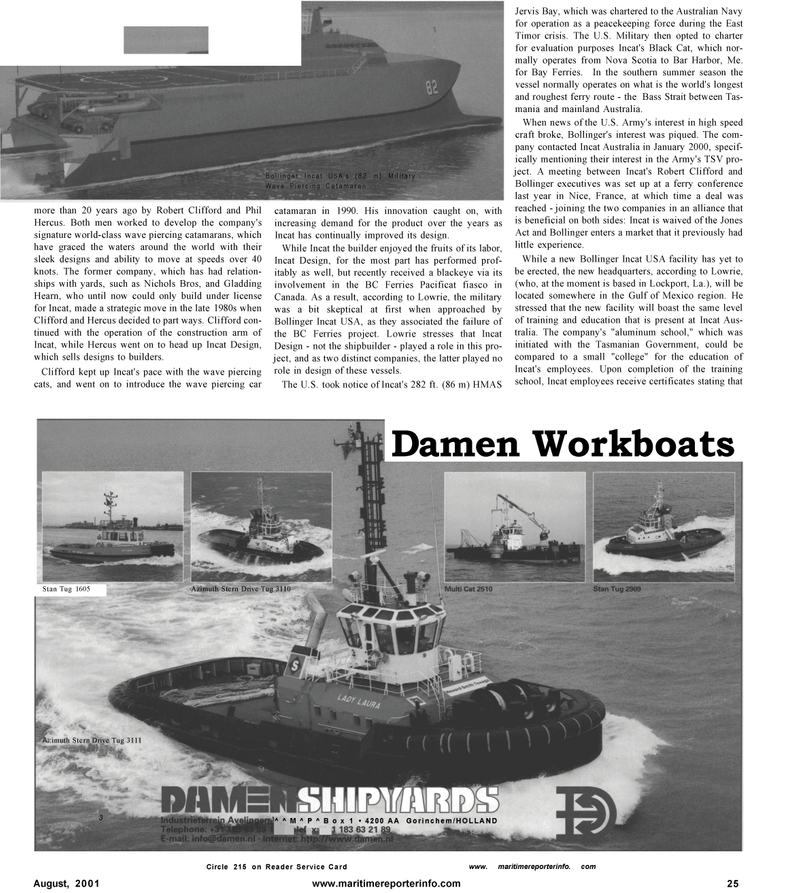
Page 27: of Maritime Reporter Magazine (August 2001)
Read this page in Pdf, Flash or Html5 edition of August 2001 Maritime Reporter Magazine
Bollinger Incat USA's (82 m) Military
Wave Piercing Catamaran. more than 20 years ago by Robert Clifford and Phil
Hercus. Both men worked to develop the company's signature world-class wave piercing catamarans, which have graced the waters around the world with their sleek designs and ability to move at speeds over 40 knots. The former company, which has had relation- ships with yards, such as Nichols Bros, and Gladding
Hearn, who until now could only build under license for Incat, made a strategic move in the late 1980s when
Clifford and Hercus decided to part ways. Clifford con- tinued with the operation of the construction arm of
Incat, while Hercus went on to head up Incat Design, which sells designs to builders.
Clifford kept up Incat's pace with the wave piercing cats, and went on to introduce the wave piercing car catamaran in 1990. His innovation caught on, with increasing demand for the product over the years as
Incat has continually improved its design.
While Incat the builder enjoyed the fruits of its labor,
Incat Design, for the most part has performed prof- itably as well, but recently received a blackeye via its involvement in the BC Ferries Pacificat fiasco in
Canada. As a result, according to Lowrie, the military was a bit skeptical at first when approached by
Bollinger Incat USA, as they associated the failure of the BC Ferries project. Lowrie stresses that Incat
Design - not the shipbuilder - played a role in this pro- ject, and as two distinct companies, the latter played no role in design of these vessels.
The U.S. took notice of Incat's 282 ft. (86 m) HMAS
Jervis Bay, which was chartered to the Australian Navy for operation as a peacekeeping force during the East
Timor crisis. The U.S. Military then opted to charter for evaluation purposes Incat's Black Cat, which nor- mally operates from Nova Scotia to Bar Harbor, Me. for Bay Ferries. In the southern summer season the vessel normally operates on what is the world's longest and roughest ferry route - the Bass Strait between Tas- mania and mainland Australia.
When news of the U.S. Army's interest in high speed craft broke, Bollinger's interest was piqued. The com- pany contacted Incat Australia in January 2000, specif- ically mentioning their interest in the Army's TSV pro- ject. A meeting between Incat's Robert Clifford and
Bollinger executives was set up at a ferry conference last year in Nice, France, at which time a deal was reached - joining the two companies in an alliance that is beneficial on both sides: Incat is waived of the Jones
Act and Bollinger enters a market that it previously had little experience.
While a new Bollinger Incat USA facility has yet to be erected, the new headquarters, according to Lowrie, (who, at the moment is based in Lockport, La.), will be located somewhere in the Gulf of Mexico region. He stressed that the new facility will boast the same level of training and education that is present at Incat Aus- tralia. The company's "aluminum school," which was initiated with the Tasmanian Government, could be compared to a small "college" for the education of
Incat's employees. Upon completion of the training school, Incat employees receive certificates stating that
Azimuth Stern Drive Tug 3110 :imuth Stern Drive Tug 3111 ^^M^P^Box 1 • 4200 AA Gorinchem/HOLLAND 3
Damen Workboats
Stan Tug 1605
Circle 215 on Reader Service Card www. maritimereporterinfo. com
August, 2001 www.maritimereporterinfo.com 25

 26
26

 28
28
